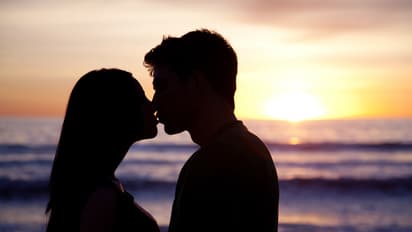Where did KISSING come from and how did it evolve? Scientist uncovers hair-raising 7 million-year-old mystery

Synopsis
In a thought-provoking new study, evolutionary psychologist Professor Adriano Lameira of Warwick University proposes a fascinating theory about the origins of human kissing.
There's no doubt that kissing is one of the most primitive human urges. However, have you ever wondered why do human beings exactly kiss? In a ground-breaking new study, psychologist Professor Adriano Lameira of Warwick University has proposed a fascinating theory about the origins of kiss. According to his research, this universal human act, which is often viewed as an expression of love, affection and desire, could possibly have its roots in the behaviours of our hairy ancestors millions of years ago.
Scientists have for over centuries pondered the reasons behind why human beings kiss. In the past some theorists have suggested that kissing helps strengthen the immune system through the exchange of bacteria, while others stated that it serves as a form of 'sniffing'. However, Professors Lameria's recent hypothesis places the act of kissing in our evolutionary past.
The grooming ritual
As per his research, published in the journal Evolutionary Anthropology, the act of kissing may have originated from a technique used by our hairy ancestors to groom one another. Professor Lameira argues that in a bid to groom one another a slight sucking action with pursed lips may have been involved. He notes that this action would help the removal of parasites, such as ticks and lice, from each other's fur.
The theory, dubbed 'the groomer's final kiss', argues that grooming sessions of our hairy ancestors covered the entire body, but eventually culminated in mouth-to-mouth contact. Professor Lameira further noted that as human beings evolved, gradually losing their body hair, these lengthy grooming sessions became shorter and shorter. However, the final act of mouth-to-mouth contact persisted among our ancestors, which eventually transformed into the kissing that we recognize in today's world.
"The hygienic relevance of grooming decreased over human evolution due to fur-loss. But shorter sessions would have predictably retained a final “kissing” stage, ultimately remaining the only vestige of a once ritualistic behavior for signaling and strengthening social and kinship ties in an ancestral ape," he noted in his paper.
The evolutionary timeline proposed by Professor Lameira indicates that this fur-sucking technique could have developed around 7 million years ago when our ancestors transitioned from a tree-dwelling lifestyle to life on the ground, where the risk of parasitic infestation was higher.
This behavioural adaptation eventually led to humans becoming what he terms a “kissing ape” between 2 to 4 million years ago, as they continued to lose their body hair.
Historical context of kissing
The earlier documented evidence of kissing can reportedly traced back to texts from Mesopotamia around 2500 BC. In Roman culture, kissing was referred to as "savium," and it was acknowledged as a significant expression of erotic desire between romantic partners. However, the precise reasons for the evolution of kissing into a sexual act remain less clear. The close connection between the desire to kiss and the urge to have sex too remains murky.
According to Professor Lameira, various forms of kissing that exist today—from a friendly peck on the cheek to more intimate gestures—are all derived from this ancient lice-removal technique.
In an interview with MailOnline.com, Professor Lameira said, "Kissing with a sexual intent is but a special case of a much more general behaviour. Only once kissing was used as a general convention for showing affection, could kissing become a mutual mouth-to-mouth act."
One of the most intriguing aspects of Professor Lameira's theory is the assertion that no other animals engage in the act of kissing in the same way as human beings do. He emphasizes that especially the protruding lips and slight suction involved is an act that remains common only among humans. He further concluded that with time kissing evolved into a powerful symbol of trust and love among humans.
"Few natural human signals carry the symbolism and social sanctions of kissing. Evidence supports that kissing isn't a derived signal of affection in humans. It instead represents a surviving devolved, vestigial form of primate grooming that conserved its ancestral form, context, and function," he concluded.
Explore the latest Lifestyle News covering fashion, wellness, travel, Food and Recipes, and more. Stay updated with trending Health News, fitness tips, and expert insights to inspire your daily living. Discover personalized lifestyle trends that keep you stylish and informed. Download the Asianet News Official App from the Android Play Store and iPhone App Store for everything that adds value to your everyday life.